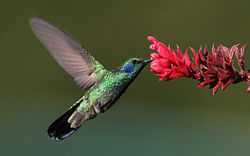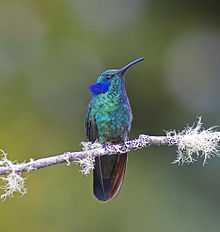Green violetear
| Green violetear | |
|---|---|
 | |
| Conservation status | |
| Scientific classification | |
| Kingdom: | Animalia |
| Phylum: | Chordata |
| Class: | Aves |
| Order: | Apodiformes |
| Family: | Trochilidae |
| Genus: | Colibri |
| Species: | C. thalassinus |
| Binomial name | |
| Colibri thalassinus (Swainson, 1827) | |
 | |
| Range of C. thalassinus | |
The green violetear (Colibri thalassinus) is a medium-sized, metallic green hummingbird species commonly found in forested areas from Mexico to northern South America.

Taxonomy
The green violetear belongs to the order Apodiformes. Hummingbirds share this order with the swifts, such as the white-collared swift. The name Apodiformes is derived from the Greek words "a pous," meaning "without foot." While apodiforms do in fact have feet, they are quite small and their legs are short and relatively weak. Many birds in this order cannot walk, and thus rarely if ever land on the ground since quick escape from predators is virtually impossible. For this reason members of this order spend a majority of their time in the air.
The violetear genus (Colibri) includes three other species: sparkling violetear, brown violetear, and white-vented violetear. The green and sparkling violetears are similar in appearance and overlap in range but are generally found at different altitudes and in different habitats. These four hummingbirds are characterized by their violet ear patches. In all four species there is no strong sexual dimorphism.
Description
The green violetear is roughly medium-sized by hummingbird standards. It averages around 9.7 to 12 cm (3.8 to 4.7 in) in total length. Its bill is black and mostly straight with only a slight downward curve and measures from 1.8 to 2.5 cm (0.71 to 0.98 in).[2][3] The body mass can vary from 4.8 to 5.6 g (0.17 to 0.20 oz).[4] Among standard measurements, the wing chord is 5.8 to 6.8 cm (2.3 to 2.7 in) and the tail is 3.5 to 4.3 cm (1.4 to 1.7 in).[5] It is shining green above with a glittering violet ear-patch on the sides of its neck. Its throat and chest are a more glittering green with a shining green belly. The tail is a metallic blue-green with more bronzy central feathers and a prominent black subterminal band.
Vocalizations
Solitary males sing from high, exposed twigs in their territory every day. Their song is a monotonously repeated sharp and dry “tsu-tzeek” at a rate of about one call per second.
Distribution and habitat
Distribution
The green violetear breeds from the highlands of southern Mexico south to Honduras; the highlands of Costa Rica and western Panama; mountains of northern Venezuela, and the Andes from western Venezuela to western Bolivia. It is a rare but annual nonbreeding visitor to the United States, primarily southern and central Texas, with scattered records as far north as extreme southern Canada.[6]
Habitat
Common habitats for the green violetear is in the canopy and borders of subtropical and lower temperate forest, secondary woodland and scrub, and clearings and gardens in the subtropical zone on both slopes of the Andes. It is recorded mostly between altitudes of 1,200 to 2,300 m (3,900 to 7,500 ft), though they will sometimes wander as far down as 500 m (1,600 ft) in search of food sources. It generally prefers more humid and high-altitude areas, such as cloud forests, than the similar sparkling violetear and is completely absent from the central valley where the sparkling violetear is most prevalent. However, the two species will sometimes be seen in the same areas feeding at flowering Inga trees.
Behavior
Diet

The green violetear forages alone but tends to gather at flowering trees, especially coffee-shade Inga. They feed at mid-level to canopy and often hold and defend a feeding territory. They primarily feed on nectar and small insects. The green violetear has been recorded as attaining the greatest flying speed ever recorded for a hummingbird, with a pair of birds having attained 90 mph (140 km/h) during a chase, although other species may be able to attain similar speeds.[7]
Breeding
Like most hummingbirds, the green violetear is a solitary nester. The male’s only involvement in the breeding process is to attract and mate with the female. The female is then responsible for choosing a nest location, generally on a low, small horizontal branch in a protected area. The nest is small and built from various plant materials, spider webs, and down woven together to form a sturdy cup structure. Two small white eggs are laid within the nest and the female incubates them on her own. Incubation time is 14–18 days. Hatchlings are primarily fed insects due to high nutritional requirements. No information was found on the length of the nestling stage or age at fledgling. Breeding takes place though the wet season into the early dry season, which varies by latitude.[8]
Migration
Seasonal movements of the green violetear are not well understood. Many individuals of northern populations move south or and/or to lower elevations following the end of the breeding season (July to November in Mexico), but regular occurrence hundreds of kilometres north of this range suggests a more complex migration strategy.[8][6]
References
- ↑ BirdLife International (2012). "Colibri thalassinus". IUCN Red List of Threatened Species. Version 2013.2. International Union for Conservation of Nature. Retrieved 26 November 2013.
- ↑ Hilty, S.L.; Brown, W.L. (1986). A Guide to the Birds of Colombia. Princeton, New Jersey: Princeton University Press. ISBN 978-0691083728.
- ↑ Howell, S.N.G.; Webb, S. (1995). A Guide to the Birds of Mexico and Northern Central America. New York, New York: Oxford University Press. ISBN 978-0198540120.
- ↑ Weske, J.S. (1972). The distribution of the avifauna in the Apurimac Valley of Peru with respect to environmental gradients, habitat, and related species (Ph.D.). Norman, Oklahoma: University of Oklahoma.
- ↑ Wetmore, A. (1968). The Birds of the Republic of Panama. Part 2. Columbidae (pigeons) to Picidae (woodpeckers). Smithsonian Miscellaneous Collections. vol. 150, part 2. Washington, D.C.: Smithsonian Institution Press.
- ↑ 6.0 6.1 Williamson, Sheri (2001). A Field Guide to Hummingbirds of North America. New York, NY: Houghton Mifflin Harcourt. p. 199. ISBN 0-618-02496-4.
- ↑ Wood, Gerald (1983). The Guinness Book of Animal Facts and Feats. ISBN 978-0-85112-235-9.
- ↑ 8.0 8.1 Hobbs, Mo; Arizmendi, M.C.; Rodríguez-Flores, C.; Soberanes-González, C. (2011). Schulenberg, T.S., ed. "Green Violetear (Colibri thalassinus)". Neotropical Birds Online. Ithaca: Cornell Lab of Ornithology.
- Ridgely, Robert S.; Greenfield, Paul J. (2001). The Birds of Ecuador: Field Guide. Ithaca, New York: Cornell University Press. ISBN 0-8014-8721-8.
- Ridgely, Robert S.; Greenfield, Paul J. (2001). The Birds of Ecuador: Status, Distribution, and Taxonomy. Ithaca, New York: Cornell University Press. ISBN 0-8014-8720-X.
- Restall, Robin (2007). Birds of Northern South America: An Identification Guide. New Haven and London: Yale University Press. ISBN 978-0-300-10862-0.
External links
| Wikimedia Commons has media related to Colibri thalassinus. |
| Wikispecies has information related to: Colibri thalassinus |
- Green Violet-ear videos, photos, and sounds at the Internet Bird Collection
- Article discussing vagrancy to the USA and Canada at Greg Lasley Nature Photography
- Green violetear stamps (for Costa Rica, El Salvador) with Range Map at bird-stamps.org
- Green violetear photo gallery at VIREO (Drexel University)
